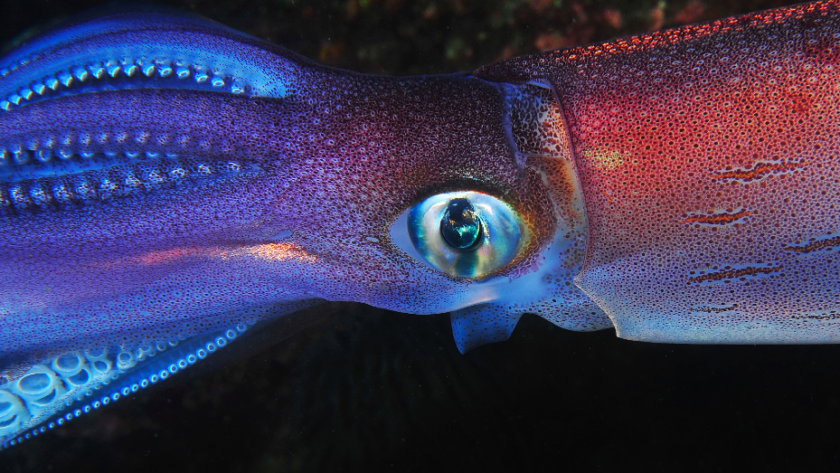We know it exists, but the giant squid is one of the largest and most mysterious creatures on the planet but they are also extremely elusive.
These massive beasts are considered the real-life Kraken and could be extremely dangerous if they lived somewhere that people could go. Thankfully, they don’t. Most of them live in a world without sunlight, which is why we know so little about them. When you think about it, this makes sense. We know very little about what lurks in the depths of the ocean because we can’t reach those areas to explore them and might not truly want to.
Even Modern Tech Hasn’t Caught this Creature
No scientist had ever photographed these massive creatures until 2005. Until 2013, none had been filmed either. Even so, many scientists believe this large creature numbers in the millions. Much of what we know about them comes from floating carcasses and the belly of sperm whales. That doesn’t give us an idea of what these squids are like when they are alive. The closest we’ve come to understanding more about them happened when an NOAA expedition captured the first footage of one of these giants in American waters.
Much Speculation Leaves this Giant to the Imagination
We know very little about the giant squid, but one writer put it well. David Gran of The New Yorker wrote that this animal can be “larger than a whale and stronger than an elephant, with a beak that can sever steel cables.” That doesn’t sound like a creature that we want to mess with. These animals can grow up to 40 feet long, as far as we can tell, but since we know so little, their maximum size is unknown. Let’s look at a few of the things we do know and consider how much we still don’t understand.
Giant Squid Live Deep in the Ocean
The shallowest water we’ve seen these massive creatures reach is approximately 1,300 feet deep. They seem to enjoy waters up to 3,000 feet deep. At these depths, humans cannot survive. The waters are too cold, offer too much pressure, and there isn’t any light, which makes orientation nearly impossible. These massive squids inhabit the deepest, darkest places in the world and no one knows for sure how deep they can go, how large they can grow, or what their life cycle is.
We Can’t Study What We Would with Other Animals
A lot is known about animals on land and fish that inhabit areas where we can survive, but not about this massive squid. We don’t know how they find partners, how they migrate, where they lay eggs, or if they make any sounds at all. These are some of the simplest and most basic items that we could ask to understand, and we have no concept of anything for these creatures. By inhabiting an area so deep, we are left in the dark, much like their entire environment seems to be.
Stories Written About These Creatures
Because we’ve had so little contact with a giant squid in the history of mankind, only legends are told of them. Sure, there could have been a couple of these massive creatures that came much closer to the surface and attacked human boats, but we don’t know for sure. We do know they have been around for nearly 730,000 years and are the inspiration for the Kraken in Norse mythology, and the bests in Jules Vern’s 20,000 Leagues Under the Sea. Other than these tales, there isn’t much that we understand about these squid at all.
Sperm Whales Tell the Tale
We only know some truths about these giant sea creatures because of what sperm whales have to tell us. About 150 years ago sailors notices sucker scars on the skin of some sperm whales. These scars appear to be the result of an underwater tussle between the whales and the squids. In some cases, it was evident the whales won because beaks have been found in the whales’ stomachs. These signs were the only evidence we had of a creature roaming the depths of the ocean that we didn’t yet understand and would not encounter.
Entering Science and a Fight on the Surface
We don’t expect the giant squid to surface, but some reports tell us this has happened. In 1873, three fishermen in Conception Bay, Newfoundland, encountered one of these creatures and fought it off. The squid swam away but the fishermen secured 19 feet of a tentacle, proving these creatures exist. Not many years before this encounter, in 1857, Danish zoologist Japetus Steenstrup introduced this massive creature to the scientific community. He studied a beak that washed ashore in Denmark and published his research. He called the animal Achiteuthis Dux, which is Latin for “ruling squid” which certainly seems appropriate for this creature.
Many Carcasses Have Washed Up
Unlike many other sea creatures that we know little about, the carcasses of giant squid have washed up often. This happens because these animals are filled with ammonium ion which is lighter than seawater. This causes them to float after they die. Unfortunately, we don’t get to study them alive. That would tell us a lot more about what happens in the darkest places of the ocean. We do get to understand how large these creatures can be when they die and wash up to the surface.
We Know this Giant to be a Predator
The most recent studies of these massive creatures involve the use of bait and a camera designed to work in the depths of the ocean without disrupting the environment. With the right equipment, a giant squid was recorded in its natural habitat for the first time ever in 2012. The squid attached the camera which was made to look like a jellyfish. This confirmed that this creature is a predator and not a laid-back floater in the depths of the ocean.
There’s still so much to learn about these elusive creatures. They never seem to show themselves except to fishermen or after they have passed on. Hopefully, scientists will learn more about them and other creatures in the darkest depths of the ocean in the future.
This post may contain affiliate links. Meaning a commission is given should you decide to make a purchase through these links, at no cost to you. All products shown are researched and tested to give an accurate review for you.




